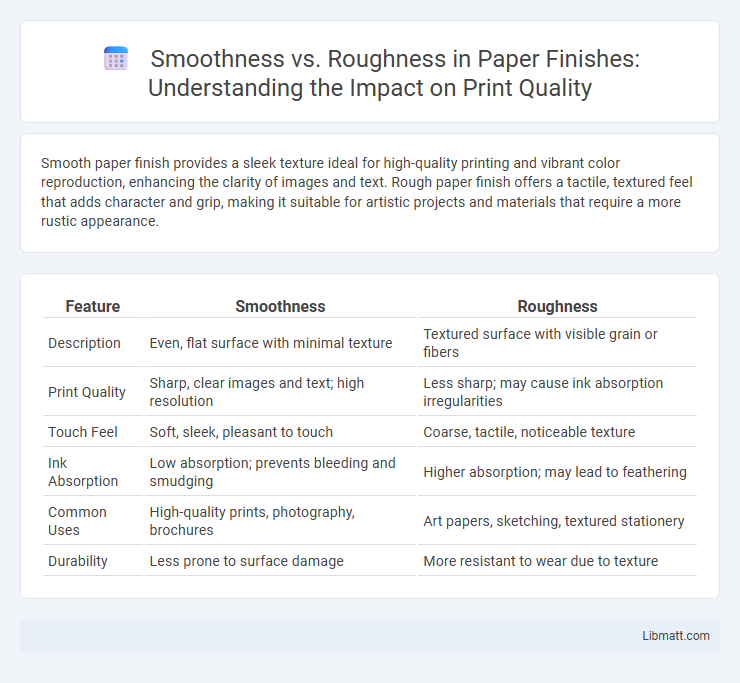Smooth paper finish provides a sleek texture ideal for high-quality printing and vibrant color reproduction, enhancing the clarity of images and text. Rough paper finish offers a tactile, textured feel that adds character and grip, making it suitable for artistic projects and materials that require a more rustic appearance.
Table of Comparison
| Feature | Smoothness | Roughness |
|---|---|---|
| Description | Even, flat surface with minimal texture | Textured surface with visible grain or fibers |
| Print Quality | Sharp, clear images and text; high resolution | Less sharp; may cause ink absorption irregularities |
| Touch Feel | Soft, sleek, pleasant to touch | Coarse, tactile, noticeable texture |
| Ink Absorption | Low absorption; prevents bleeding and smudging | Higher absorption; may lead to feathering |
| Common Uses | High-quality prints, photography, brochures | Art papers, sketching, textured stationery |
| Durability | Less prone to surface damage | More resistant to wear due to texture |
Introduction to Paper Finishes
Smoothness and roughness are key attributes defining paper finishes, directly impacting the texture and tactile experience of printed materials. Paper smoothness enhances ink adhesion and image clarity, providing a polished and professional look, while roughness adds a tactile dimension often preferred for artistic or textured designs. Your choice of paper finish influences printing quality and the overall feel, making it essential to select the right balance between these two characteristics for your specific project.
Defining Smoothness and Roughness
Smoothness refers to the evenness and uniformity of a paper's surface, characterized by minimal texture and irregularities, which enhances ink absorption and print clarity. Roughness describes a paper surface with noticeable texture or grain, often causing varied ink distribution and tactile feedback. Understanding these properties helps optimize your choice for specific printing techniques and desired visual effects.
Manufacturing Processes Affecting Texture
Manufacturing processes such as grinding, polishing, milling, and casting significantly influence the smoothness or roughness of paper surfaces by altering fiber alignment and surface energy. Surface treatments like calendering improve smoothness by compressing fibers, reducing porosity, and enhancing gloss, whereas less refined methods result in rough textures with higher friction coefficients. Controlling parameters like roller pressure, temperature, and speed during these processes is critical to achieving the desired paper finish for specific applications.
Types of Smooth Paper Finishes
Glossy, matte, and satin are the primary types of smooth paper finishes used in printing and packaging. Glossy finishes offer a shiny, reflective surface ideal for vibrant color reproduction, while matte finishes provide a non-reflective, smooth texture that reduces glare and enhances readability. Satin finishes strike a balance between glossy and matte, delivering moderate sheen with a smooth feel that enhances color depth without excessive shine.
Types of Rough Paper Finishes
Rough paper finishes include cold-pressed, which has a textured surface ideal for watercolor and mixed media, and rough-grain papers featuring pronounced texture that enhances brush strokes and pigment absorption. You can also find handmade rough papers with irregular, coarse surfaces that offer a tactile quality valuable for artistic effects and printmaking. Understanding these types helps you choose the best paper finish for your specific creative needs.
Visual and Tactile Effects
Smooth paper surfaces reflect light evenly, enhancing visual clarity and sharpness of printed images while providing a sleek, professional appearance. Tactilely, smooth finishes feel soft and polished, promoting a comfortable and refined touch experience ideal for high-quality prints. In contrast, rough paper textures scatter light, creating a matte, diffused look that softens visuals and offers a more organic, tactile sensation often preferred for artistic and handmade aesthetics.
Printing Performance and Ink Absorption
Smooth paper finishes enhance printing performance by allowing ink to sit uniformly on the surface, resulting in sharper images and vibrant colors, while rough finishes increase ink absorption, reducing ink bleed but potentially dulling image sharpness. Your choice between smoothness and roughness affects drying time; smoother papers often dry faster due to less ink penetration, whereas rougher papers absorb more ink, which can extend drying times but improve durability. Optimizing paper finish based on your printing needs ensures a balance between image clarity and ink absorption efficiency.
Choosing the Right Finish for Projects
Selecting the appropriate paper finish depends on project requirements such as texture, appearance, and printing method. Smooth finishes provide a sleek, polished look ideal for detailed images and text clarity, while rough finishes offer tactile appeal and a more natural feel, suitable for artistic or rustic designs. Understanding the desired visual effect and functional purpose ensures the paper finish enhances the overall quality and impact of the printed material.
Advantages and Limitations of Each Finish
Smooth paper finish offers a sleek surface ideal for high-resolution printing and sharp image reproduction, enhancing visual clarity and detail. Rough paper finish provides better ink absorption and texture, which adds depth and a tactile quality perfect for artistic or watercolor prints. Your choice depends on the desired aesthetic and printing technique, balancing smoothness for precision and roughness for texture and ink control.
Trends and Innovations in Paper Finishes
Innovations in paper finishes focus on enhancing smoothness to improve print quality and tactile experience, with developments in nanocoating and microtextured surfaces gaining traction. Trends show a growing demand for customizable finishes that balance aesthetic appeal and functional durability, such as soft-touch laminates and anti-glare coatings. Your choice of paper finish can now leverage eco-friendly materials and advanced finishing technologies to meet both sustainability goals and consumer preferences.
Smoothness vs roughness (paper finish) Infographic

 libmatt.com
libmatt.com